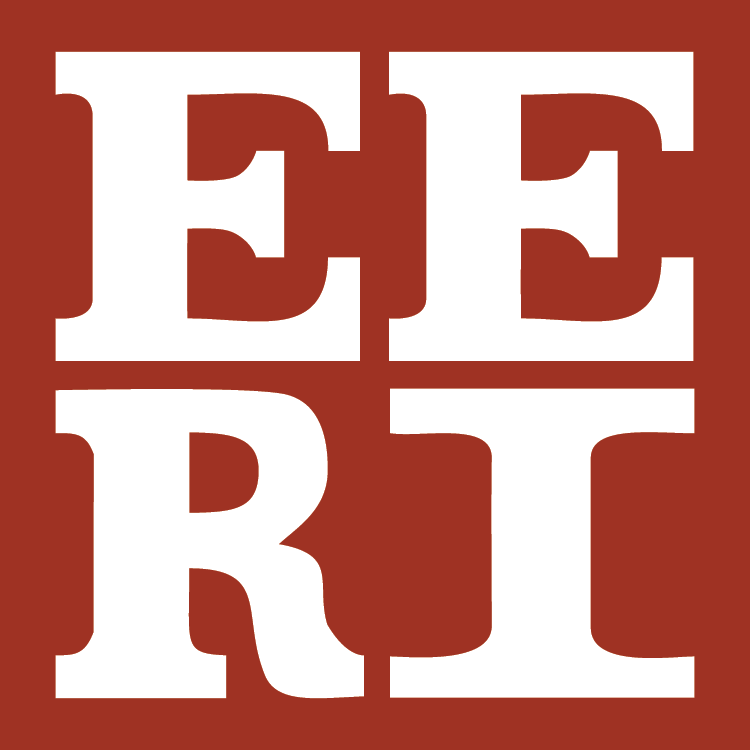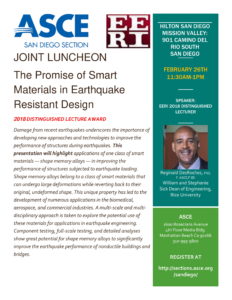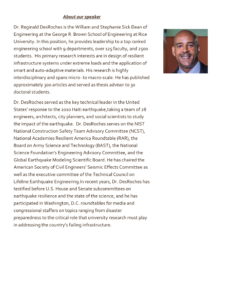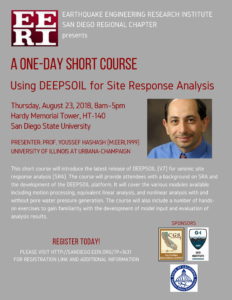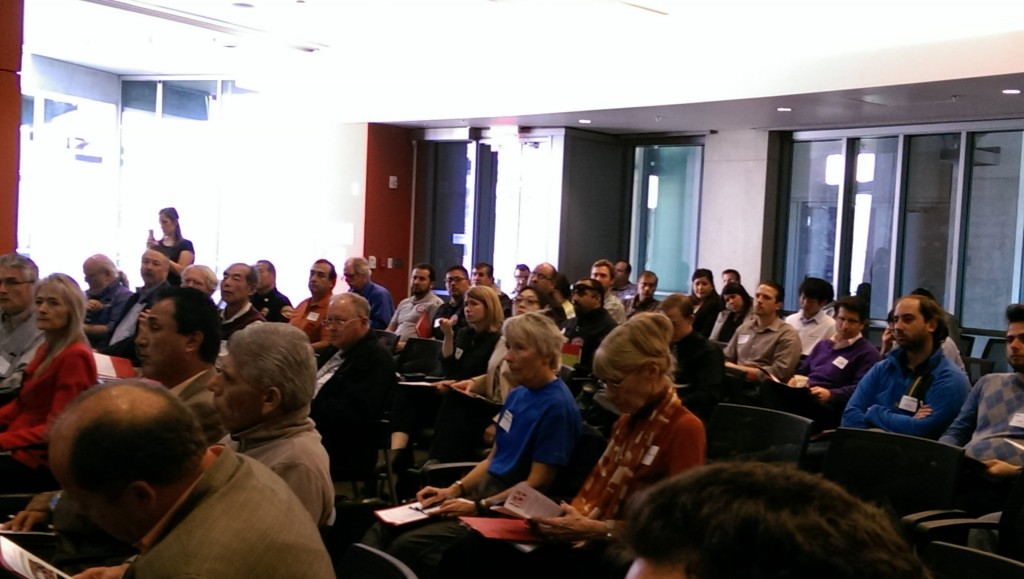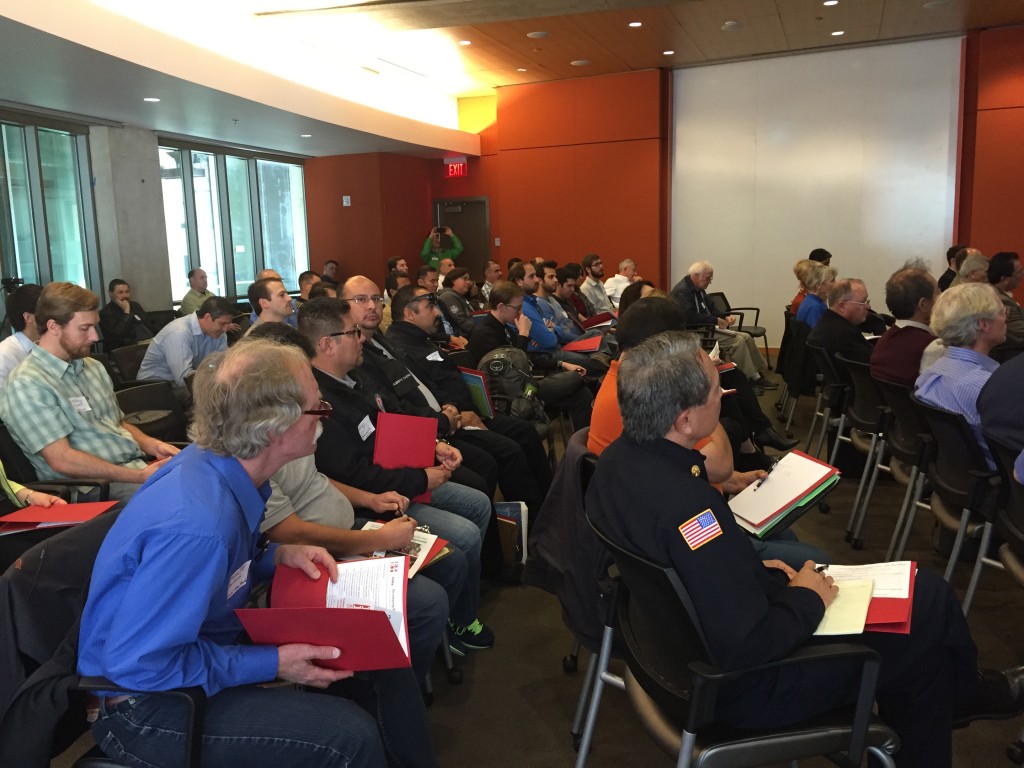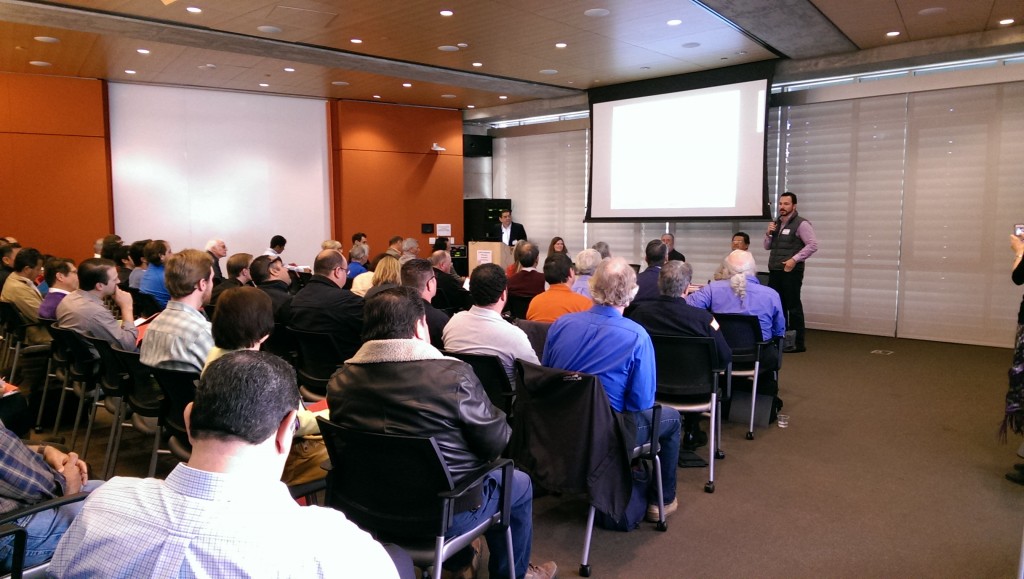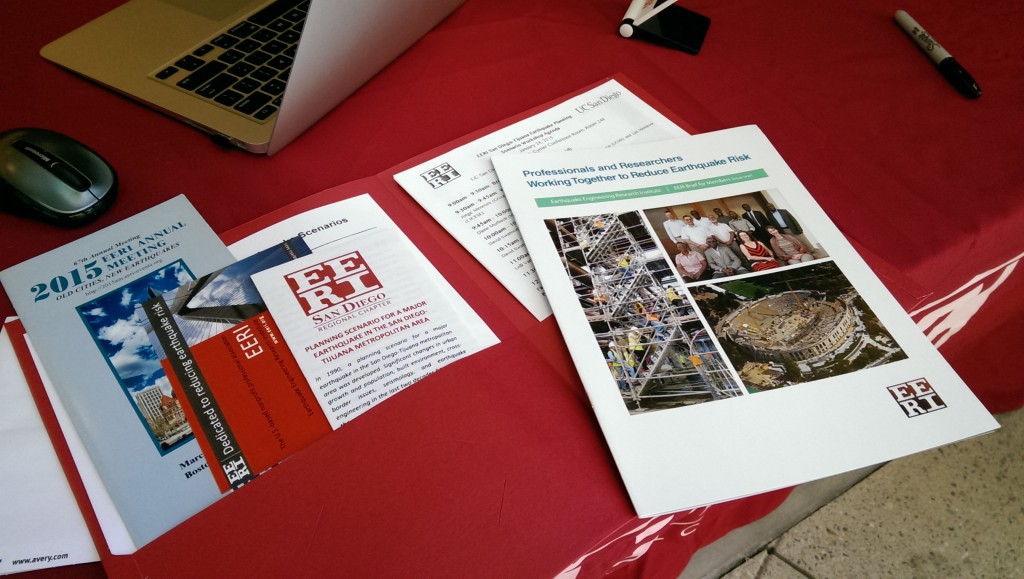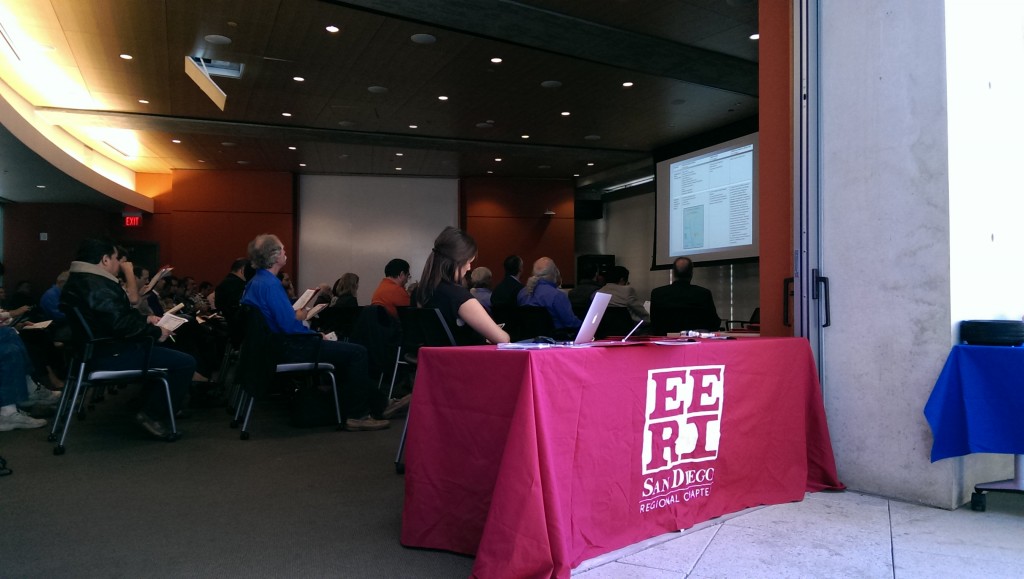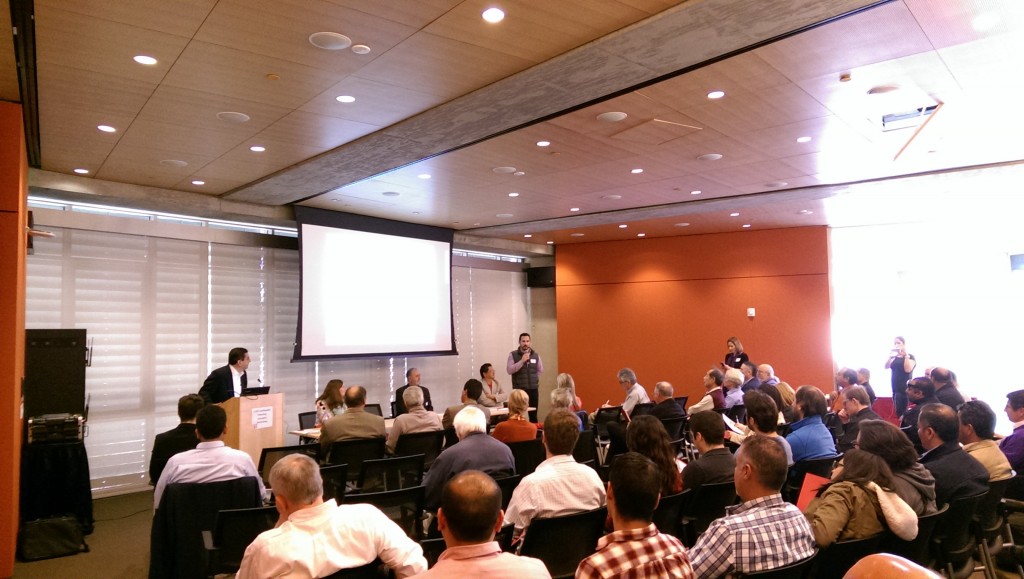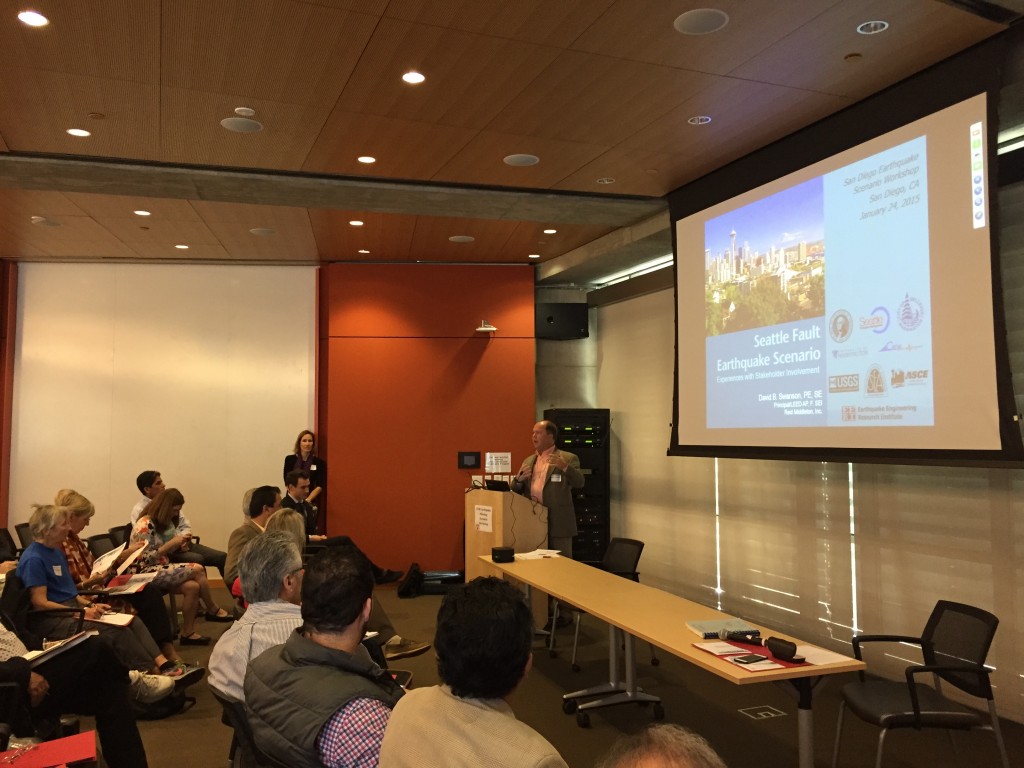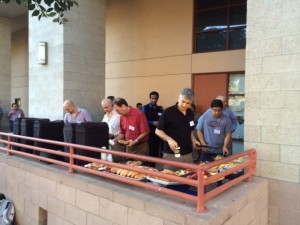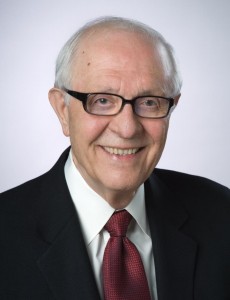ASCE EERI Joint Luncheon
THE PROMISE OF SMART MATERIALS IN EARTHQUAKE RESISTANT DESIGN
Tuesday, February 26th, 2019
11:30am-1:30pm
Hilton San Diego Mission Valley
San Diego, CA
Join EERI in a joint luncheon with ASCE San Diego Section, featuring guest speaker Dr. Reginald DesRoches, EERI 2018 Distinguished Lecturer. The presentation will discuss the use of smart materials in bettering structural performance against seismic activity.
For members of EERI and ASCE = $35.00
For non-members = $45.00
For public agency workers = $20.00
For students or lifetime members = $15.00
For more information, click the images below to view event flyers:
REGISTRATION
Click here to register for the luncheon.
VENUE
Hilton San Diego Mission Valley
901 Camino Del Rio South
San Diego, CA 92108
2018 December Dinner Meeting
EARTHQUAKE INSURANCE
Monday, December 10th, 2018
6:00pm-8:30pm
San Diego State University, Faculty-Staff Club
San Diego, CA
Free Parking
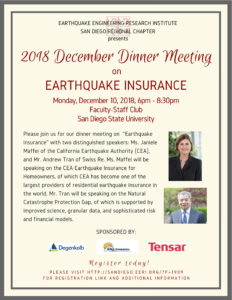 The topic of this dinner meeting is “Earthquake Insurance” with two distinguished speakers: Ms. Janiele Maffei, California Earthquake Authority, and Andrew Tran, Swiss Re. Further information on the talks and brief biographies of the speakers are presented below.
The topic of this dinner meeting is “Earthquake Insurance” with two distinguished speakers: Ms. Janiele Maffei, California Earthquake Authority, and Andrew Tran, Swiss Re. Further information on the talks and brief biographies of the speakers are presented below.
For members of EERI, ASCE, SEOSD, SDAG, AIA = $35.00
For non-members = $40.00
Click image on right to view event flyer.
REGISTRATION
Click here to register for the meeting.
PRESENTATIONS
CEA Earthquake Insurance for Homeowners, by Janiele Maffei
In 1996, the California Legislature went one step further and created the California Earthquake Authority (CEA)—a not-for-profit, publicly managed, privately funded entity. CEA places a high priority on educating California homeowners and renters about how to stay safe during an earthquake, and how to reduce the risk of earthquake damage and loss.
The CEA’s Chief Mitigation Officer developed earthquake guidelines which created statewide retrofit standards that are used to reduce earthquake damage in single-family dwellings. The CEA Mitigation Department manages multiple projects focused on expanding mitigation resources to homeowners and technical professionals; these projects also support the mitigation-related insurance-premium discount for CEA policyholders.
About 76 percent of California residential property insurance companies offer CEA earthquake policies. By selling our policies exclusively through these participating insurance companies, CEA has become one of the largest providers of residential earthquake insurance in the world.
Natural Catastrophe Gap, by Andrew Tran
At Swiss Re, our vision statement is “We make the world more resilient”: one area of focus is Natural Catastrophe Protection Gap. Improved science and granular data along with sophisticated risk and financial models; we are taking steps to close the protection gap.
SPEAKERS
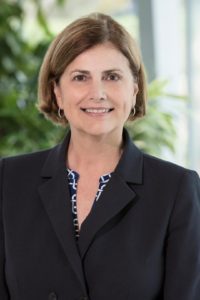 Janiele Maffei, Chief Mitigation Officer, California Earthquake Authority, Sacramento, CA
Janiele Maffei, Chief Mitigation Officer, California Earthquake Authority, Sacramento, CA
As Chief Mitigation Officer of the CEA, Janiele Maffei is responsible for planning and directing the statewide residential retrofit program; leading the processes of developing and promoting educational programs that stress the importance of mitigation; collaborating with academic institutions, and industries to promote and support mitigation research and activities; and other actions that promote seismic mitigation and support mitigation-related insurance-premium discount for CEA policyholders.
Ms. Maffei also serves as the Executive Director of the California Residential Mitigation Program, a Joint Power Authority of the CEA and Governor’s Office of Emergency Services since its inception in August 2011. She is a registered structural engineer who has worked in the earthquake engineering industry for over 36 years. Her experience includes the design of new building structures and seismic strengthening of existing structures. Ms. Maffei earned her AB in Architecture and M.S. in Civil Engineering from the University of California at Berkeley.
Ms. Maffei served on EERI director board from 2012 to 2018. She worked on the organizing committee of the 2010 EERI Annual Meeting in San Francisco. She is a member of the Structural Engineers Association of California and served on their Board from 1995-1997. She participated in post-earthquake reconnaissance investigations following the Loma Prieta, Northridge, and South Napa earthquakes.
Andrew Tran, Senior Vice-President, Swiss Re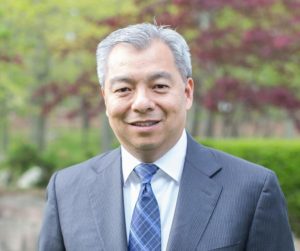
Andy is a Senior Vice President and Head Property Underwriting for US Core Partners Group at Swiss Re. One of his main responsibilities is to manage the underwriting of the Property reinsurance treaty portfolio. Outside of Swiss Re, Andy serve the as a commissioner on the California Seismic and Safety Commission and vice chairman of the Extreme Events Committee as part of the American Academy of Actuaries.
Since joining Swiss Re in 1996, he has held many lead roles including pricing property and casualty reinsurance business, managing loss reserve estimates, and financial reporting including actuarial opinions. And prior to joining Swiss Re, Andy was with Fireman’s Fund Insurance Company and Sullivan Brokerage Companies.
Andy graduated from the University of California of Los Angeles with a BS in Applied Mathematics and Science. He is an Associate of the Casualty Actuarial Society (ACAS), a Member of the American Academy of Actuaries, and Chartered Property and Casualty Underwriter (CPCU).
VENUE
Faculty-Staff Club
San Diego State University
5500 Campanile Drive
San Diego, CA 92182
PARKING INFORMATION
Parking is free for attendees. Please park in Levels 1 & 2 (bottom two levels) of Parking Structure 1, which can be seen on SDSU’s interactive map or on Google Maps.
Directions to Parking Structure 1 and the Faculty-Staff Club:
From Interstate 8 East, take Exit 10 at College Avenue. Proceeding south, turn right at the stoplight onto College Avenue. Then, turn left at the next stoplight–as you turn, you will see Parking Structure 1 immediately on your right. The entrances to Levels 1 & 2 will also be on your right; please park on these two floors.
Take the elevator to Level 6. Then, cross the bridge at Level 6 and climb the set of stairs that run next to the Education and Business Administration Building (which will be on your left). Cross the street and proceed to the Faculty-Staff Club.
ORGANIZING COMMITTEE
Chair: Dr. Jorge Meneses
Janna Bonfiglio
Alvaro Celestino
Maryam Motamed
Tasneem Sadeque
Kenji Ishihara Colloquium Series on Earthquake Geotechnical Engineering
“Seismic Settlements”
Friday, August 24, 2018
San Diego State University, Hardy Memorial Tower (HT-140)
San Diego, CA
 The first of this colloquium series will focus on seismic settlements and will take place in the Hardy Memorial Tower at San Diego State University on Friday, August 24 between 8 AM and 5 PM. The topics that will be presented on during the colloquium are oriented towards geotechnical engineers, structural engineers, engineering geologists, architects, civil engineers, researchers, and students. Speakers, that include geotechnical and structural engineers, set to present at this colloquium include Prof. Jonathan Bray, Prof. Kohji Tokimatsu, Prof. Youssef Hashash, Prof. Susumu Yasuda, Craig Comartin, Stephen Harris, and other engineers and professors from the US and Japan.
The first of this colloquium series will focus on seismic settlements and will take place in the Hardy Memorial Tower at San Diego State University on Friday, August 24 between 8 AM and 5 PM. The topics that will be presented on during the colloquium are oriented towards geotechnical engineers, structural engineers, engineering geologists, architects, civil engineers, researchers, and students. Speakers, that include geotechnical and structural engineers, set to present at this colloquium include Prof. Jonathan Bray, Prof. Kohji Tokimatsu, Prof. Youssef Hashash, Prof. Susumu Yasuda, Craig Comartin, Stephen Harris, and other engineers and professors from the US and Japan.
Registration includes breakfast, lunch, and refreshments during the breaks.
Click here for information on each speaker and their presentations.
PROGRAM
Opening Ceremony
| Refreshments/Registration | 7:00am | 8:00am |
| EERI | 8:00am | 8:05am |
| GI | 8:05am | 8:10am |
Session 1 – Moderator: Anthony B. Court, SE, SEAOC Fellow
| Prof. Youssef Hashash (University of Illinois at Urbana-Champaign) | Numerical Modeling and Simulation of Seismic Settlements in Dense Sands | 8:15am | 8:40am |
| Prof. Scott M. Olson (University of Illinois at Urbana-Champaign) | Semi-empirical estimates of shaking-induced settlement in saturated coarse-grained soils with or without a structure | 8:40am | 9:05am |
| Break | 9:05am | 9:10am | |
| Prof. John S. McCartney (University of California, San Diego) | Role of Unsaturated Soil Mechanics in the Prediction of Seismic Compression | 9:10am | 9:35am |
| Prof. Shideh Dashti (University of Colorado Boulder) | Physics-Informed Semi-Empirical Probabilistic Models for Predicting Building Settlement and Tilt on Liquefiable Ground | 9:35am | 10:00am |
| 4 speakers | Discussion Panel | 10:00am | 10:30am |
| Break | 10:30am | 10:45am | |
| Prof. Edward J. Cording (University of Illinois at Urbana-Champaign) | Damage criterion for buildings subjected to lateral displacement and differential settlement | 10:45am | 11:10am |
| Craig D. Comartin, SE (CDComartin, Inc.) | Structural effects of large seismically induced permanent ground displacement | 11:10am | 11:35am |
| Stephen Harris, SE (Simpson Gumpertz & Heger) | ASCE 7-16 provisions on seismic settlements for liquefiable sites | 11:35am | 12:00pm |
| Lunch Break (Provided) | 12:00pm | 1:00pm | |
| 3 speakers | Discussion Panel | 1:00pm | 1:30pm |
Session 2 – Moderator: Dr. Jorge Meneses
| Prof. Jonathan D. Bray (University of California, Berkeley) | Simplified Assessment of Liquefaction-Induced Building Settlement | 1:30pm | 2:00pm |
| Prof. Kohji Tokimatsu (Tokyo Soil Research Co., Japan) | Liquefaction-induced Settlement and Tilting of Buildings with Shallow Foundations from Centrifuge Experiments | 2:00pm | 2:30pm |
| Speakers | Discussion Panel | 2:30pm | 3:00pm |
| Break | 3:00pm | 3:15pm | |
| Garrett Fountain, PE, GE (Tensar International) | Geogrid-Stabilized Gravel Rafts to Mitigate Liquefaction-Induced Differential Settlement | 3:15pm | 3:40pm |
| Dr. James R. Gingery (Hayward Baker, Inc.) | Ground Improvement to Mitigate Seismic Settlement of Buildings | 3:40pm | 4:05pm |
| Prof. Susumu Yasuda (Tokyo Denki University, Japan) | Ground improvement design procedure to mitigate liquefaction-induced settlement of buildings | 4:05pm | 4:30pm |
| Discussion Panel | 4:30pm | 5:00pm | |
VENUE
San Diego State University
Hardy Memorial Tower, Room HT-140
5500 Campanile Drive
San Diego, CA 92182
Click here for an interactive map of the venue.
Click here for parking information. Please park in Parking Structure 12, 7, or 3.
REGISTRATION
Click here to register for the colloquium.
LODGING
Click here for a list of hotels near San Diego State University.
Click here for an additional list of a series of hotels (Hotel Circle) located ~12 minutes driving distance from the venue.
TRANSPORTATION
Click here for a transportation map from Hotel Circle to the venue.
Transportation to and from the venue can also be utilized through Uber or Lyft.
ORGANIZING COMMITTEE
Chair: Dr. Jorge Meneses
Vice-Chair: Prof. Julio R. Valdes
Janna Bonfiglio
Alvaro Celestino
Metehan Gumustekin
Lydia Marshall
Federick Pinongcos
Tasneem Sadeque
For sponsorship opportunities, please contact Dr. Jorge Meneses at jmenesesl@gmail.com.
Speaker Information: Kenji Ishihara Colloquium Series on Earthquake Geotechnical Engineering
“Seismic Settlements”
Speakers and Abstracts
Professor Youssef Hashash
University of Illinois at Urbana-Champaign
Numerical Modeling and Simulation of Seismic Settlements in Dense Sands
Abstract: The seismic performance of structures constructed on compacted, dense sands depends on the cyclic shear stress – shear strain – volumetric strain response of the underlying soil. Dense natural or compacted coarse-grained soils are not expected to liquefy during an earthquake. However, a thick granular deposit may experience accumulated volumetric strains due to seismic loading resulting in nontrivial total and differential settlements of structures. In these situations, reliable estimations of seismic settlements are essential for assessing the effects of earthquakes on the safety and serviceability of the structures.
This presentation describes results of series of numerical simulations using nonlinear three dimensional finite element analyses, to estimate the seismic settlements measured with depth in dynamic centrifuge tests conducted on dense, saturated sand under multi-directional seismic loading conditions with and without structure (free-field). The numerical simulations use a general, three dimensional effective stress soil model (I-soil) to describe important aspects of dense sands including small-strain nonlinearity, hysteretic damping, shear induced volumetric (contraction – dilation) behavior in terms of strains and excess porewater pressures, and effective mean stress dependency of the stress – strain behavior. I-soil uses distributed element plasticity (DEP) framework and does not require kinematic hardening rule. Thus, the mathematical formulation and numerical implementation is simple and efficient. The model is implemented in a transient dynamic finite element analysis software that uses explicit time integration. Model validation and input calibration utilized results from an extensive laboratory testing program (using cyclic direct simple shear testing), empirical relations developed for modulus reduction and damping curves, and one-dimensional nonlinear site response analyses for free-field centrifuge tests. The calibrated model is, then, used in 3-D SSI simulations. The results show that the simulations reasonably represent settlements measured under seismic loadings having various intensity levels for with and without structure cases. In addition, run times for full scale, 3-D SSI analyses are on the order of a couple of hours per broad band ground motion.
Professor Scott M. Olson
University of Illinois at Urbana-Champaign
Semi-empirical estimates of shaking-induced settlement in saturated coarse-grained soils with or without a structure
Abstract: Settlement of saturated, sandy soils during earthquakes is a pervasive problem, particularly when liquefaction is triggered. Structures are particularly vulnerable to damage resulting from shaking-induced settlements, as recently demonstrated by the dramatic economic losses resulting from shaking- and liquefaction-induced settlements of multi-story frame structures and one- to two-story residences during the 2010-11 Canterbury earthquake sequence. Despite the magnitude of the problem, empirical and semi-empirical methods to estimate shaking-induced settlements largely have been limited to free-field conditions (i.e., outside of the soil region affected by normal and shear stresses imposed by a structure) under idealized undrained or drained conditions. A few recent studies have focused on shaking-induced settlements of structures, and provide valuable insights for understanding the influence of structures on these settlements.
In this presentation, we will describe the development and validation of new, consistent semi-empirical models for estimating shaking-induced vertical strains and settlements in the free-field and below structures. The new models focus on partially drained conditions that commonly occur during earthquake shaking, use shear wave velocity or penetration resistance to capture soil state and compressibility, and use various intensity measures to capture seismic demand. Specifically, we simplified the calculations into three components: (1) settlement during shaking; (2) reconsolidation settlement after shaking; and (3) a punching/rocking mechanism when buildings are present. The models apply to a wide range of realistic field conditions involving liquefiable and non-liquefiable saturated sandy soils with shear wave velocity ranging from about 50 to 300 m/s and Arias intensities ranging from about 0.1 to 3.0 m/s. Data for the models were obtained from a dynamic centrifuge testing program (involving uni- and multi-directional shaking) and a thorough review of 1g shaking-table tests, dynamic centrifuge tests, and well-documented free-field and building settlement case records.
Bio: Scott M. Olson, PhD, PE is an associate professor in the CEE Department at the University of Illinois, where he joined the faculty in 2004. Prior to joining the faculty at Illinois, Scott worked in practice for about seven years for Woodward-Clyde Consultants and URS Corporation. Prof. Olson has researched static and seismic liquefaction for over 20 years, and has been involved in dozens of research and consulting projects involving geotechnical earthquake engineering including seismic hazard; site response; liquefaction; slope stability, and ground modification. Dr. Olson’s other research interests include laboratory/centrifuge testing, paleoliquefaction, insitu testing, geohazard analysis, and soil-foundation-structure interaction. From these activities, Scott has published over 120 journal papers, conference articles, and reports, and has received numerous awards for his research and teaching. Scott serves in various capacities for the Geo-Institute, USUCGER, and the Transportation Research Board (TRB), and remains active in consulting with clients in the civil infrastructure, power, transportation, and mining industries. He is a licensed professional engineer in Missouri.
Professor Shideh Dashti
University of Colorado Boulder
Physics-Informed Semi-Empirical Probabilistic Models for Predicting Building Settlement and Tilt on Liquefiable Ground
Abstract: This presentation introduces predictive models for the seismic settlement and tilt of shallow-founded structures on liquefiable ground based on an integrated observational, experimental, numerical, and statistical approach. Effective liquefaction mitigation requires an improved understanding of the consequences of liquefaction on structures. The state of practice typically involves estimating building settlement using empirical procedures for free-field conditions, which have been shown to be unreliable and inappropriate through previous case histories and physical model studies. To address this problem, first, a series of centrifuge experiments were performed to evaluate the dominant mechanisms of deformation near shallow-founded structures. Second, experimental results were used to evaluate the predictive capabilities of 3D, fully-coupled, nonlinear, dynamic finite element analyses of soil-structure systems in OpenSees. Third, a numerical parametric study (exceeding 63,000 simulations) was used to identify the most optimum Intensity Measures for permanent building settlement and tilt as well as the functional form of predictive models. And finally, a case history database helped validate and refine the models, accounting for field complexities not captured numerically or experimentally. This integrative approach yielded a set of procedures that are the first to consider variations in soil layering and geometry, foundation and structure properties (in 3D), soil-structure interaction, and total model uncertainties—all of which are necessary to realize the benefits of performance-based seismic design in evaluating and mitigating the liquefaction hazard.
Bio: Dr. Shideh Dashti is a faculty member in Geotechnical Engineering and Geomechanics at the University of Colorado Boulder (CU). She obtained her undergraduate degree at Cornell University and graduate degrees at the University of California, Berkeley. She worked briefly with ARUP (New York City) and Bechtel (San Francisco) Geotechnical groups on several engineering projects in the US and around the world involving the design of foundation systems, slopes, and underground structures and tunnels. Her research team at CU studies: the interactions and interdependencies among different infrastructure systems during earthquakes and other types of disasters; the seismic performance of underground structures; and consequences and mitigation of the liquefaction hazard facing structures in isolation and in dense urban settings.
URL: https://shidehdashti.com
Dr. James R. Gingery
Hayward Baker
Ground Improvement to Mitigate Seismic Settlement of Buildings
Abstract: Ground improvement has a long history as a mitigation strategy for seismically induced settlement of building foundations. Experience has shown that seismic performance of structures supported by ground improvement has generally been good. But good performance depends on the sound design practices that target performance criteria. In this presentation, the basic shear- and volume-related mechanisms of seismic settlement will be reviewed. Various methods of ground improvement, including aggregate piers, soil mixing, rigid inclusions, compaction grouting and jet grouting, will be reviewed with respect to their ability to counteract the various seismic settlement mechanisms. Key issues related to design of ground improvement for seismic settlement mitigation will be reviewed. Recent work on methods to account for the reinforcing effect on volumetric seismic settlements will be discussed. This information will be presented with an eye toward the implications of major changes in ASCE 7-16 for design of foundations on liquefiable ground.
Bio: Dr. James Gingery is a Chief Engineer in Hayward Baker, Inc.’s western region. He has over twenty years of experience in geotechnical and earthquake engineering for water, energy, transportation, industrial/commercial and residential projects. Dr. Gingery specializes in seismic hazard characterization and mitigation, particularly liquefaction, slope stability, surface fault rupture and soil-structure interaction. He also has worked extensively in soft ground engineering and underground construction. He earned a B.S. in Civil Engineering from San Jose State University, an M.S. in Geotechnical Engineering from U.C. Berkeley and a Ph.D. focused on geotechnical earthquake engineering from U.C. San Diego. Dr. Gingery as a 2015 recipient of the Shamsher Prakash Price for Excellence in the Practice of Geotechnical Engineering.
Garrett Fountain, PE, GE
Tensar International
Geogrid-Stabilised Gravel Rafts to Mitigate Liquefaction-Induced Differential Settlement
Abstract: While guidance documents for both California and New Zealand already recommend geogrid-stabilized gravel rafts as a shallow ground improvement method to mitigate liquefaction-induced settlement, they lack a design method to tailor the solution to site-specific conditions. In this presentation, a new design method will be described to address this need and which will also be used to explain the effectiveness of this ground improvement technique. Case studies of stabilized gravel rafts subjected to the Canterbury Earthquake Sequence will also be presented.
Bio: Mr. Fountain is a 1999 Civil Engineering graduate from the University of Arizona with an emphasis in geotechnical engineering. His professional engineering licenses include the states of Arizona, Nevada, California, Idaho, Montana, Oregon, Washington, Hawaii and Wyoming. Additionally, Garrett is licensed as a Geotechnical Engineering in the states of California and Oregon. He has over 20 years of geotechnical engineering and construction experience. As Tensar’s West Area Engineer Garrett provides engineering support for Tensar’s regional managers and key clients in the application of geosynthetics and value engineering. Additionally, Garrett assists in numerous research and testing programs on various transportation and foundation projects. Garrett is based out of San Diego, California.
Professor Susumu Yasuda
Tokyo Denki University, Japan
Ground improvement design procedure to mitigate liquefaction-induced settlement of buildings
Abstract: A design procedure to mitigate liquefaction-induced settlements on buildings is presented along with some case histories in Japan. The design procedure includes definition of the allowable settlement and tilting of buildings, delineation of the area and depth of ground improvement, and finally selection of the ground improvement method. Case histories on new and existing buildings in Japan will be presented and discussed.
Bio: Dr. Susumu Yasuda is professor of civil and environmental engineering and vice president at Tokyo Denki University. He was born in Hiroshima in 1948. He received his B.S. in civil engineering from Kyushu Institute of Technology, and his Dr. of Engineering in civil engineering from University of Tokyo in 1975. Following his Dr. of Engineering, he worked at Kiso-jiban Consultants Co. as a geotechnical consulting engineer. He joined Kyushu Institute of Technology in 1986, and then moved to Tokyo Denki University in 1994. His main research interest is in soil liquefaction during earthquakes. He visited many countries to investigate the damage due to liquefaction. He was the Vice President of the Japanese Geotechnical Society in 2006 to 2007 and the President of Japan Association for Earthquake Engineering from 2013 to 2014. In the International Society for Soil Mechanics and Geotechnical Engineering, he was the chairman of the Asian Technical Committee (ATC) No.10 on Urban Geo-informaticsman in 2002 to 2006 and the chairman of the ATC No.3 on Geotechnology for Natural Hazards in 2006 to 2010. Now, he is the Vice President of Tokyo Denki University.
Professor Jonathan D. Bray
University of California, Berkeley
Simplified Assessment of Liquefaction-Induced Building Settlement
Abstract: Significant settlement and damage may occur due to liquefaction of soils beneath shallow-founded buildings. Liquefaction-induced settlement of buildings on shallow foundations requires evaluation of shear-induced, volumetric-induced, and ejecta-induced ground settlement mechanisms. There are simplified procedures available for estimating volumetric-induced settlement, which are largely due to post-liquefaction one-dimensional reconsolidation settlement for free-field conditions. However, there are few well-established simplified procedures for estimating shear-induced building settlement due to liquefaction. Nonlinear dynamic soil-structure interaction (SSI) effective stress analyses can capture this mechanism (e.g., Luque & Bray 2017). It is the basis for a recently developed procedure by Bray & Macedo (2017) for estimating the shear-induced component of liquefaction-induced building settlement. The liquefaction-induced building settlement (LBS) index characterizes the cyclic shear strain potential of the soils underlying the structure to estimate shear-induced liquefaction building settlement. The Bray & Macedo (2017) procedure is shown to provide estimates of liquefaction-induced building settlement consistent with those observed. Thus, it offers engineers a reliable simplified procedure for estimating liquefaction-induced building displacements. The Bray & Macedo (2017) simplified procedure is discussed and applied to a field case history to provide insights in this talk.
Professor Kohji Tokimatsu
Tokyo Soil Research Co., Japan
Liquefaction-induced Settlement and Tilting of Buildings with Shallow Foundations from Centrifuge Experiments
Abstract: In order to examine relative importance of key parameters affecting liquefaction-induced settlement and tilting of buildings with shallow foundations, centrifuge experiments were made. It is shown that: (1) The liquefaction-induced relative settlement and tilting of shallow foundations tend to increase with increasing contact pressure and ground settlement, and with decreasing groundwater table and thickness of the non-liquefied crust; (2) The tilt angle of the building also tends to increase with increasing eccentric mass and distance ratio; and (3) The safety factors against vertical load and dynamic overturning moment are key indicators to estimate liquefaction-induced damage to buildings with rigid shallow foundations.
Bio: Kohji Tokimatsu is a Professor Emeritus, Tokyo Institute of Technology and currently serves as an Executive Managing Director, Tokyo Soil Research Co., Ltd. Tokimatsu’s research area lies principally in geotechnical earthquake engineering with emphasis on liquefaction and its remediation, seismic soil-pile-structure interaction, and geotechnical and geophysical site characterization; through advanced dynamic field and laboratory testing, dynamic full-scale and centrifuge shaking-table experimentation, and earthquake reconnaissance together with theoretical and numerical studies. Major awards were received for outstanding technical papers from JGS, in 1988 and 2006, and from AIJ in 2003, as well as the Thomas A. Middlebrooks Award, ASCE, conferred in 2006. In 2009 he was awarded the Prize for Science and Technology, by MEXT for the significance of his contributions to geotechnical earthquake engineering research.
Professor Edward J. Cording
University of Illinois at Urbana-Champaign
Damage criterion for buildings subjected to lateral displacement and differential settlement
Abstract: Current distortion and damage criterion for buildings subjected to ground movements is summarized, and examples are provided showing the effects of lateral and vertical ground movement on buildings, based on field observations, and numerical and physical modelling.
Boscardin and Cording (1989) developed a relationship for masonry building damage due to lateral strain and angular distortion for a deep beam, extending the work of Burland and Wroth (1974) for differential settlement of masonry walls with window penetrations modeled as beams with high E/G ratios. The relationship was correlated with observations of damage due to excavation- and tunneling-induced ground movements and with relationships developed over the past 60 years for buildings settling under their own weight, displacing laterally due to deep mine subsidence, and displacing vertically and laterally due to urban excavation and tunneling. Damage levels were based on observations of masonry structures.
The Boscardin and Cording relationship for lateral strain and angular distortion has been updated, with minor modification of boundaries, and expressed in terms of the state of strain at a point (Cording, et. al. 2001, 2010). The boundaries between damage zones are constant values of maximum principal extension strain. The relationship can be used to represent the average state of strain in the bottom or top of a structural bay, for infill or cladding, or finished walls in a frame structure, as well as for a masonry beam.
Subsequent to the Boscardin and Cording work, observations have been made of excavation- and tunneling-induced damage to a number of different types of masonry structures, and results have been correlated with numerical and physical modelling of masonry structures.
Bio: B Sc Geology, Wheaton College, 1960.
M Sc, PhD, Civil Engineering, University of Illinois 1963, 1967.
Design, construction, analysis of 120-ft- dia. rock caverns in weak, stress slabbing tuft, Nevada.
1965-67 US Army Corps of Engineers, Waterways Experiment Station, & U.S.A.E. Command, Vietnam.
Professor Emeritus, Dept. of Civil & Environmental. Engineering, Univ. of Illinois at Urbana-Champaign.
Teaching and research in geotechnical engineering with emphasis on the observation and analysis of rock and soil behavior on engineering projects, utilizing the field as the laboratory in the areas of rock mechanics and engineering geology, soil-structure interaction, underground construction. Conducted instrumentation program for Washington Metro Phase 1 construction of station cavern in rock, braced excavations, and shield tunnels,Assessment and control of tunneling- and excavation-induced ground movements. Field observations, and numerical and physical modeling of building distortion, lateral strain, and damage due to excavation and tunneling. Developed building distortion/damage criterion. Geotechnical Consultant: Recent Projects include: Current Projects include: Honors:
New York City: Long Island Railroad East Side Access Project: siting and initial design recommendations for terminal in rock caverns beneath Grand Central Terminal; 2nd Avenue Subway; evaluation of rock cavern and tunnel ground and support condition; Metropolitan Transportation Authority Capital Construction: construction of No. 7 line TBM tunnels and station caverns; THE Partnership: design of Trans-Hudson tunnels in soil and station caverns in rock.
Toronto Transit Commission: Control of ground movements for Earth Pressure Balance (EPB) tunneling at shallow depth beneath York University building’; Feasibility of large diameter tunnels for running tunnels, stations, and cross-overs on the Scarborough line.
Port Mann, B. C Water Tunnel: Construction of 60-m-deep shafts & EPB tunnel beneath Fraser R.
LA Metro Tunnel Advisory Panel: design & construction of transit tunnels & underground stations.
Alaskan Way Viaduct Replacement Project, Seattle Tunnel Partners: Ground monitoring & control of 17.5-m-diameter EPBM during tunneling beneath downtown Seattle.
DC WATER Tunnel Review Panel. design & construction of Blue Plains, Anacostia River, and Northeast Boundary, Potomac River tunnel projects.
California High Speed Rail Project: Technical Advisory Panel.
Member, National Academy of Engineering, 1989;
ASCE Martin S. Kapp Award;
Moles Non-member Award for Outstanding Achievement in Construction, 2003;
ASCE Geo Institute Harry Schnabel Award for Career Excellence in Earth Retaining Structures,
Outstanding Educator Award, UCA of SME, 2012;
Beaver’s Engineering Award for Outstanding Achievement in Heavy Engineering Construction, 2013
Fellow, American Rock Mechanics Association, 2013.
Stephen Harris, SE
Simpson Gumpertz & Heger
ASCE 7-16 provisions on seismic settlements for liquefiable sites
Abstract: ASCE7-16 includes specific provisions for design of structures on liquefiable sites. The liquefaction provisions require design for seismic settlements computed considering MCEg ground motions. Most of the seismic provisions in ASCE7 are based on providing life-safe facilities under the design earthquake, which is defined as 2/3 of the risk-adjusted MCE. These new provision differ, as they are based on the higher level of ground shaking, but with a reduced performance expectation of avoiding collapse. As such, the provisions explicitly allow inelastic structural behavior. This presentation includes an overview of the new provisions, a discussion of the limitations on the use of shallow foundations, and description of the design requirements for shallow and deep foundation systems on liquefiable sites.
Bio: Stephen Harris has practiced structural engineering for over 30 years and is a principal at Simpson Gumpertz & Heger Inc. He is a graduate of the University of California at Davis and a registered Structural Engineer. His experience includes design of new structures, seismic strengthening of existing structures and design of pile foundation systems. His pile foundation designs include the 49ers Levi’s Stadium, three new buildings for Facebook in Menlo Park, the new SFO Control Tower, and Google’s new Charleston East Facility in Mountain View. Other noteworthy projects include the seismic upgrade of the War Memorial Veterans Building in San Francisco, the expansion, remodel, and seismic upgrade of the J. Paul Leonard & Sutro Library at San Francisco State University, and design of the 29-story 199 Fremont office building in San Francisco.
Craig D. Comartin, SE
CDComartin, Inc.
Structural effects of large seismically induced permanent ground displacement
Abstract: This presentation addresses the behavior of structures subject to large seismically induced permanent horizontal and vertical displacements. Such displacements can occur as the result of fault movement or land sliding beneath structures. Examples of observations in past earthquakes illustrate concepts of basic behavior mechanisms. The structural consequences of these characteristic mechanisms are idealized for structural analysis and design purposes. General application for displacements hazards is discussed. Several examples of new design and retrofit of major structures are reviewed. These include:
- Anchorage Courthouse, Supreme Court of Alaska
- California Memorial Stadium, University of California, Berkeley
- Bowles Hall, University of California, Berkeley
Bio: Craig Comartin is a graduate of Santa Clara University (BSCE 1971) and the University of California, Berkeley (MSCE 1973). He has been a practicing Structural Engineer in seismically active regions of the world for over forty years. He is the engineer of record for structures in California, Oregon, Washington, Utah, Alaska, and the Marianas Islands. He consults on construction projects and collaborates with researchers throughout the world. Clients include the Bay Area Rapid Transit System, Stanford University, and the University of California, Office of the President, as well as the Berkeley, Davis, UCLA, Santa Cruz, and UCSF campuses. He has lead investigations of past earthquakes in Guam, Japan, Iran, and Turkey. For the last 25 years, he has focused on the development and application of performance-based design (PBD) to earthquake engineering. He is responsible to the initial development and incorporation of foundation-structure interaction into seismic analysis and design. He has also developed and applied procedures for accommodating large permanent seismically-induced displacements beneath structures to avoid collapse. Craig is the founding director of the Concrete Coalition, a grassroots program of the Earthquake Engineering Research Institute, to improve the safety of existing concrete buildings worldwide. He is a former President and Honorary Member of the Earthquake Engineering Research Institute. He is an Honorary Member of the Structural Engineers Association of Northern California.
Using DEEPSOIL: An equivalent linear and nonlinear seismic site response analysis software platform
A 1-Day Short Course
Professor Youssef Hashash, University of Illinois at Urbana-Champaign
Thursday, August 23, 2018, 8:00am – 5:00pm
San Diego State University
PURPOSE
This short course will introduce the latest release of DEEPSOIL (V7) for seismic site response analysis. The course will provide attendees with a background on SRA and the development of the DEEPSOIL platform. It will cover the various modules available including motion processing, equivalent linear analysis, nonlinear analysis with and without pore water pressure generation. The course will also include a number of hands-on exercises to gain familiarity with the development of model input and evaluation of analysis results.
Registration includes breakfast, lunch, and refreshments during the breaks.
PROGRAM
| Time | Topic |
|---|---|
| 8:00am–8:30am | Registration |
| 9:00am–9:30am | Introduction to DEEPSOIL & Historical Background |
| 9:30am–10:00am | Ground Motion Processing Tools |
| 10:00am–10:15am | Morning Break |
| 10:15am–12:00pm | Linear and Equivalent Linear Analyses in DEEPSOIL Hands-On Examples |
| 12:00pm–1:00pm | Lunch |
| 1:00pm–3:00pm | Time Domain Analyses in DEEPSOIL *Numerical Setting *Modified Kodner-Zelasko Model *General Quadratic/Hyperbolic Model *Equivalent Linear/Nonlinear Threshold *Hands-On Examples |
| 3:00pm–3:15pm | Afternoon Break |
| 3:15pm–4:30pm | Pore Water Pressure Generation and Dissipation Hands-On Examples |
| 4:30pm–5:00pm | Additional Features and Future Developments *Auto-Generated Soil Profiles *Randomization *Future Directions |
VENUE
San Diego State University
Hardy Memorial Tower, Room HT-140
5500 Campanile Drive
San Diego, CA 92182
Click here for an interactive map of the venue.
Click here for parking information. Please park in Parking Structure 12, 7, or 3.
REGISTRATION
Click here to register for the short course.
LODGING
Click here for a list of hotels near San Diego State University.
Click here for an additional list of a series of hotels (Hotel Circle) located ~12 minutes driving distance from the venue.
TRANSPORTATION
Click here for a transportation map from Hotel Circle to the venue.
Transportation to and from the venue can also be utilized through Uber or Lyft.
ORGANIZING COMMITTEE
Chair: Dr. Jorge Meneses
Vice-Chair: Prof. Julio R. Valdes
Janna Bonfiglio
Alvaro Celestino
Metehan Gumustekin
Lydia Marshall
Federick Pinongcos
Tasneem Sadeque
FLYER
2nd WORKSHOP ON GEOTECHNICAL EARTHQUAKE ENGINEERING
(Photos from the workshop and short course: Part 1 Part 2 Part 3 Part 4)
“DEALING WITH THE CONSEQUENCES OF LIQUEFACTION”
HONORING THE LIFETIME ACHIEVEMENTS AND CONTRIBUTIONS OF PROF. KENJI ISHIHARA
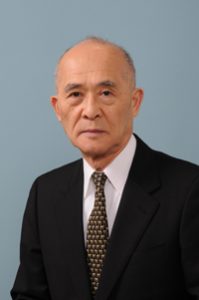 Organized by the Earthquake Engineering Research Institute (EERI) San Diego Chapter, University of California San Diego Extension, and Geo-Institute San Diego Chapter.
Organized by the Earthquake Engineering Research Institute (EERI) San Diego Chapter, University of California San Diego Extension, and Geo-Institute San Diego Chapter.
Wednesday-Thursday, March 29-30, 2017
8:00am – 5:00pm
Speakers (Presentation Files):
- I.M. Idriss (Professor Emeritus, University of California, Davis) Bio
EVALUATION OF EARTHQUAKE GROUND MOTIONS AT SOFT SOIL SITES - Fumio Tatsuoka (Tokyo University of Science; Prof. Emeritus University of Tokyo) Bio Abstract
Soil compaction and its effects on the mechanical properties of compacted soil - Ross Boulanger (University of California, Davis) Bio Abstract
Seismic response of an embankment on loose sand treated with soil-cement panels: Centrifuge tests and numerical analyses - Peter K. Robertson (Gregg Drilling and Testing, Inc.) Bio Abstract
Influence of depth of liquefaction on estimated settlements - Lisheng Shao (Hayward Baker, Inc.) Bio Abstract
Quality Control for Liquefaction Mitigation - David Yang (JAFEC USA, Inc.) Bio Abstract
Application of Multi-Shaft Deep Mixing for Seismic Remediation of Earth Dams – Historical Review from Jackson Lake Dam to Perris Lake Dam - Juan Baez (Advanced Geosolutions, Inc.) Bio and Abstract
On the Performance of Ground Improvement during Strong Earthquakes – Observations and Lessons Learned - Sonja Zlatovich (Zagreb University of Applied Sciences, Croatia) Bio Abstract
Prof. Ishihara in Croatia - Daniel Pradel (The Ohio State University) Bio Abstract
Landslide Movement at Lokanthali during the Mw = 7.8 Gorkha (Nepal) Earthquake of April 25 2015 - Ramon Verdugo (CMGI Ltda., Former President of the Chilean Geotechnical Society) Bio Abstract
Critical analyses of the available methods to assess soil liquefaction potential - Marte Gutierrez (James R. Paden Distinguished Professor, Colorado School of Mines) Bio Abstract
Probabilistic Back-Analysis of Liquefied Shear Strength from Case Histories - Misko Cubrinovski (University of Canterbury, New Zealand) Bio Abstract
Liquefaction Characteristics of Sandy Soils - Ikuo Towhata (Professor Emeritus, University of Tokyo) Bio Abstract
Soil improvement project in liquefaction-damaged residential areas - Ricardo Dobry (Rensselaer Polytechnic Institute) Bio Abstract
New Findings on Liquefaction Triggering of Sands During Earthquakes - Jonathan Bray (University of California, Berkeley) Bio Abstract
Insights Through Dynamic Analysis of Structures at Liquefied Sites - Ahmed Elgamal (University of California San Diego)
- Gopal Madabhushi (University of Cambridge, England) Bio Abstract
Soil Liquefaction: To Drain or not to Drain? - Takaji Kokusho (Chuo University, Tokyo, Japan) Bio Abstract
Lab tests on applicability of S-wave-based and CPT-based liquefaction evaluations
- Sjoerd Van Ballegooy (Tonkin+Taylor, New Zealand) Bio Abstract
Predicting the Consequences of Liquefaction on Residential Buildings - Michael Fraser (NAVFAC) Bio Abstract
Uncertainty Related to Liquefaction-Induced Settlements - Liam Finn (Professor Emeritus, University of British Columbia, Canada) Bio Abstract
Liquefaction under Probabilistic Ground Motions - Tara Hutchinson (University of California San Diego) Abstract and Bio
Inelastic Pile Behavior in Partially Liquefied Soils and Layered Soil Conditions - Ellen Rathje (University of Texas, Austin) Bio Abstract
Summary of National Research Council (NRC) study on the State of the Art and Practice in
Earthquake Induced Soil Liquefaction Assessment
Organizing Committee:
Dr. Jorge Meneses (President, EERI San Diego Chapter), jmenesesl@gmail.com
Sean Ahdi
Tugce Baser
Victor Contreras
Ahmed Ebeido
Mandro Eslami
John Li
Jinchi Lu
Lan Luo
Zhijian Qiu
Wenyong Rong
Muhammad Zayed
Yewei Zheng
PURPOSE:
The workshop will honor the lifetime achievements and contributions of Professor Kenji Ishihara to the field of geotechnical earthquake engineering, with the afternoon session of the second day of the workshop entirely devoted to honor Professor Ishihara and hosted by Professor I.M. Idriss (M. EERI, 1972).
Distinguished speakers from the United States, Japan, New Zealand, Europe, and South America will share experiences with liquefaction mitigation, recent major earthquakes, and highlighting the contributions of Professor Ishihara. A one-day short course before the workshop on Tuesday, March 28, is also offered.
Target audience includes geotechnical engineers, engineering geologists, structural engineers, researchers, agencies officials and students. Panel discussions will promote exchange of ideas and clarification.
This workshop will be the second of a series of periodic workshops on the topic of geotechnical earthquake engineering.
VENUE
University of California San Diego Campus
Price Center East Ballroom
9500 Gilman Dr., La Jolla, CA 92093
For driving directions and parking information:
http://universitycenters.ucsd.edu/aboutus_directions.php
Click here for parking directions (Gilman Parking Structure)
HOTELS NEAR UCSD CAMPUS
Click here for hotels near UCSD.
REGISTRATION
Registration includes registration package and access to pdf files of the presentations. Meals and refreshments will not be provided as the lower level of the Price Center contains a great variety of food and costs.
Click here to register for the Workshop and/or 1-day short course.
Proceeds of the workshop will go the “Update of the San Diego-Tijuana Earthquake Scenario.” A Project led by the EERI San Diego Chapter with the participation of organizations from San Diego, California, and Tijuana-Ensenada, Baja California, Mexico. Further information can be found at https://sandiego.eeri.org/?page_id=265
Short Course Series on Geotechnical Earthquake Engineering
1-DAY SHORT COURSE
“LIQUEFACTION: FROM SITE CHARACTERIZATION TO USER-FRIENDLY COMPUTER PROGRAMS”
Instructors:
Prof. Ahmed Elgamal (University of California San Diego)
Michael Fraser, PhD, PE (Naval Facilities Engineering Command Southwest)
Jorge Meneses, PhD, PE, GE, D.GE, F.ASCE (RMA Group, San Diego)
Date: Tuesday, March 28, 2017
Program: 8:00 am – 5:00 pm
Venue:
UC San Diego
Structural and Material Engineering (SME) Building (UCSD Structural Engineering) (Google map)
Cymer Conference Room 248
La Jolla, CA 92093
Click here for parking directions (Gilman Parking Structure)
Content: All lectures will incorporate illustrating case histories and practical applications
- Site characterization and seismic response (Prof. Elgamal)
- Liquefaction (Dr. Fraser)
- Seismic Design Codes (Dr. Meneses)
- Hands-on Implementation and case studies (Prof. Elgamal)
Practical demonstrations using available computer programs such as Cyclic1D, OpenSees-Frequency Domain Analysis, and others. Participants will receive these computer programs and spreadsheets.
Click here to register for 1-day short course and/or the Workshop.
Program:
8:00 – 8:30 am Registration
8:30 – 10:00 am Site characterization and seismic response
10:00 – 10:15 am Morning break
10:15 – 11:45 am Liquefaction
11:45 – 1:00pm LUNCH BREAK
1:00 – 2:30 pm Seismic Design Codes
2:30 – 2:45 pm Afternoon break
2:45 – 4:15 pm Hands-on Implementation and case studies
4:15 – 5:00 pm Discussion, Q&A
5:00 – 6:30 pm Get together
1/24/2015 Workshop Meeting and Photos
Here are photos from today’s San Diego-Tijuana Earthquake Scenario workshop. The turn out was amazing and we were able to get support from both public and private stake holders including organizations such as City of San Diego Office of Emergency Services, California Geological Survey, City of Tijuana Civil Protection Office, Naval Facilities Engineering Command (NAVFAC) South West, San Diego Fire-Rescue Department, Medical College of Tijuana, Naval Medical Center San Diego, numerous Universities, and private consultants.
Thank you to everyone again for the support!
For more photos, program and details of the event, visit the page of the January 2015 Workshop.
9/12 Workshop Meeting & Photos
Here are a few photos of the guests and speakers that attended our 9/12 Workshop at the UCSD Campus. Thank you again for the support!
9/12 Workshop: Liquefaction Evaluation, Mapping, Simulation and Mitigation
1st WORKSHOP ON GEOTECHNICAL EARTHQUAKE ENGINEERING
LIQUEFACTION EVALUATION, MAPPING, SIMULATION, AND MITIGATION
Organized by the Earthquake Engineering Research Institute (EERI) San Diego Chapter
Friday, September 12
8:30am – 5:00pm
Speakers:
1) Dr. Gonzalo Castro (GEI Consultants, Inc.) Download Presentation by Castro
2) Prof. Ahmed Elgamal (UC San Diego) & Prof. Geoffrey Martin (University of Southern California)
Download Presentation by Martin and Elgamal
3) Prof. Kevin Franke (Brigham Young University) Download Presentation by Franke
4) Prof. I.M. Idriss (Prof. Emeritus, UC Davis) Download Presentation by Idriss
5) Dr. Mitsuo Nozu (Fudo Construction) Download Presentation by Nozu
6) Dr. Peter Robertson (Prof. Emeritus, University of Alberta) Download Presentation by Robertson
7) Prof. Jonathan Stewart (UC Los Angeles) Download Presentation by Stewart
Chair of Organizing Committee:
Dr. Jorge Meneses (President, EERI San Diego Chapter)
PURPOSE:
Presenters, distinguished leaders of the geotechnical earthquake engineering community, will discuss current procedures to evaluate liquefaction occurrence and consequences, map liquefaction hazards, mitigate liquefaction consequences, and numerically model the phenomenon. Target audience includes geotechnical engineers, engineering geologists, researchers, agencies officials and students. Two panel discussions will promote exchange of ideas and clarification.
This workshop intends to be the first of a series on annual workshops on the topic of geotechnical earthquake engineering and will be announced nationwide and internationally.
|
8:30-9:00 am |
Registration |
|
9:00-9:15 am |
Introduction |
|
9:15-9:45 am |
“Simplified Performance-Based Liquefaction Triggering Assessment in San Diego” Prof. Kevin Franke |
|
9:45-10:15 am |
“Liquefaction Mitigation Effects and Its Advanced Technology in Japan” Dr. M. Nozu |
|
10:15-10:45 am |
“Next Generation Liquefaction Project – Objectives and Preliminary Site Characterization Results” Prof. Jonathan Stewart |
|
10:45-11:15 am |
Break |
|
11:15-12:00 noon |
Panel Discussion |
|
12:00-1:00 pm |
Lunch break |
|
1:00-1:30 pm |
“Seismic Response of Stratified Sites and Implications for Foundation Systems” Prof. Geoffrey Martin and Prof. Ahmed Elgamal |
|
1:30-2:00 pm |
“Steel Creek Dam Revisited” Dr. Gonzalo Castro |
|
2:00-2:30 pm |
Break |
|
2:30-3:00 pm |
“Evaluating Soil Liquefaction Using the CPT-Practical Considerations” Dr. Peter Robertson |
|
3:00-3:30 pm |
“Update of the SPT- and CPT-Based Liquefaction Triggering Procedures” Prof. I.M. Idriss |
|
3:30-4:00 pm |
Break |
|
4:00-5:00 pm |
Panel Discussion |
VENUE
University of California San Diego Campus
Center Hall, Room 115
9500 Gilman Dr., La Jolla, CA 92093
For driving directions and parking information:
http://ucsd.edu/explore/maps/index.html
REGISTRATION
Registration includes pdf files of the presentations, breakfast, and refreshments during morning and afternoon breaks. Lunch will not be provided as the Price Center with a great variety of food and costs is a walkable distance.
Early-Bird Registration (if received by August 31, 2014)
EERI members $ 150
EERI non-members $ 170
Students $60
Registration from September 1, 2014
EERI members $ 170
EERI non-members $ 190
Students $70
Please RSVP Tan Cao, our Secretary/Treasurer, at tcao@kleinfelder.com by September 10.
Payment Options
Make checks payable to:
EERI San Diego
c/o Tan Cao
Kleinfelder Simon Wong Engineer
550 West C Street, Suite 1200
San Diego, CA 92101
USA
Contact Tan Cao for online credit card registration.
Payment by Cash, Check, or Credit Card will also be accepted at the door but should RSVP to tcao@kleinfelder.com by September 10.
Co-Sponsor:
ABSTRACTS AND BIOS OF PRESENTERS
Presentation Title: Simplified Performance-Based Liquefaction Triggering Assessment in San Diego
Abstract: Research has shown that the manner in which seismic loading is represented in a simplified empirical liquefaction triggering assessment significantly influences the predicted liquefaction hazard. Because probabilistic methods of ground motion prediction typically offer multiple possible seismic loading scenarios, it can be difficult for engineers to select which scenario is appropriate for use in liquefaction analysis. Recently-developed performance-based liquefaction triggering methods overcome this challenge by considering all possible seismic loading scenarios across a wide range of return periods. However, performance-based analysis methods are quite involved and difficult for engineers to implement without specialized tools. Fortunately, researchers have developed simplified map-based methods to closely approximate performance-based liquefaction triggering results at a targeted return period. This presentation will introduce such a method that has recently been created for the Boulanger and Idriss (2012, 2014) probabilistic triggering model. The potential application of the method for liquefaction assessment in San Diego will be explored. Benefits and limitations of simplified performance-based methods will be briefly discussed.
Bio: Kevin W. Franke, Ph.D., P.E. is an Assistant Professor in the Department of Civil and Environmental Engineering at Brigham Young University. Kevin’s principal research focus relates to geotechnical/earthquake engineering. Kevin and his students are currently developing performance-based (i.e., probabilistic) methods for dealing with soil liquefaction and its associated hazards. Additionally, Kevin is an investigator in the Center for Unmanned Aircraft Systems (C-UAS), which is currently the only NSF-sponsored research center for unmanned aerial vehicles (UAVs or “drones.”) Kevin’s research focus in the Center deals with new and improved applications of small unmanned aerial vehicles (sUAVs) in monitoring infrastructure and performing post-disaster reconnaissance.
Prior to his current position at BYU, Kevin worked for 6 years as a professional civil engineering consultant for Kleinfelder, Inc. and URS Corporation. Kevin contributed to multiple significant projects throughout the western and central US including Kennecott Utah Copper tailings impoundment, facilities at Los Alamos National Labs, California High Speed Rail, North Torrey Pines Bridge seismic retrofit, I-15 Corridor Reconstruction in Utah County, Sacramento Area Flood Control Authority Levee Evaluations/Improvements, Levee improvements in New Orleans, Roscoe Wind Farm, Legacy Parkway, and multiple schools and hospitals throughout CA, OR, and WA.
Kevin received his BSCE from Utah State University in 2004, is MSCE from University of Washington in 2005, and his Ph.D. from Brigham Young University in 2011. He and his wife of 13 years, Ruby, have 6 young children.
Presentation Title: Liquefaction Mitigation Effects and Its Advanced Technology in Japan
Abstract: In this presentation, at first the liquefaction mitigation effects for Sand Compaction Pile and other techniques against past huge earthquakes in Japan will be introduced. In particular, the impressive effects in Urayasu-City for 2011 Tohoku earthquake are explained in detail. In addition, it is depicted some derivative effects such as initial stress change and unsaturated condition due to sand compaction pile installation. Finally, one advanced technology named ‘SAVE-SP’ method, in which the liquid sand flow is sent through the grout pump into the ground to compact it with the static expansion effect.
Bio: Major: Design, construction and quality control of Ground improvement works such as Deep Soil Mixing, Dynamic Compaction, Vertical drain, Sand compaction pile, and Jet grouting / Countermeasures against Liquefaction / Numerical analysis for deformation using Elasto-Plastic constitutive model (Cam-clay model), Seismic analysis incl. Liquefaction and Seepage analysis / Vibration Isolation works of Trains & Road with special gas-filled wall. Qualifications: Registered Consulting Engineer from Japanese government, 1990; Dr. Eng. from Nagoya University, 1995; APEC Engineer, 2001
Work Experience: 1984-2014: FUDO CONSTRUCTION Co., Ltd.; 1985-1988: Civil Engineer, Yanbu Medical Center foundation construction site, Saudi Arabia; 1996-1999 JICA project team member for ground improvement of Highway in Thailand; 2002-2014 Part-time lecturer of Nagoya University; 2005 Regional Reporter in Asia, Deep Mixing 2005, International conference in Stockholm, Sweden; 2005 Session secretary in ISSMFE Osaka conference; 2006-2014 International Department of Fudo Tetra Corporation; 2005 QC & Design Engineer of Test trial for Off-shore SCP in South Korea; 2006 QC & Design manager of Omon Thermal Power Plant, Vietnam; 2007-2008 QC & Design manager of SP-PSA Container Terminal, Vietnam; 2007-2012 General manager of International Department; 2008-2009 QC & Design manager of New Orleans Levee Improvement Project, U.S.; 2009-2010 QC & Design manager of Thi-Vai Container Terminal, Vietnam; 2012-2014 QC manager of Fort Lauderdale Airport Expansion Project, Florida, U.S. Education: 1978-1982: Nagoya University, Major: Geotechnical Engineering (Prof. A. Asaoka); 1982-1984: Graduate school (ditto).
Presentation Title: Next Generation Liquefaction Project – Objectives and Preliminary Site Characterization Results
Abstract: This presentation will describe the objectives and scope of the Next Generation Liquefaction (NGL) project being organized through the Pacific Earthquake Engineering Research Center. The project is working towards development of an international community database of ground failure case histories, including cases of liquefaction triggering, non-ground failure cases, and case histories of measured ground deformations. Ultimately we envision multiple modeling teams working with the common data set, and benefitting from a number of supporting studies, to develop next-generation models for liquefaction triggering, post-liquefaction residual strength, and deformation effects.
Bio: Jonathan P. Stewart is Professor and Chair of the Civil & Environmental Engineering at UCLA. He joined UCLA as an Assistant Professor in 1997, advancing to tenure in 2003 and full Professor in 2007. He has served previously as the CEE Vice Chair for Undergraduate Studies (2005-2007) and as the CEE Graduate Advisor (2007-2012).
Professor Stewart’s technical expertise is in geotechnical earthquake engineering and engineering seismology, with emphases on seismic soil-structure interaction, engineering characterization of earthquake ground motions, seismic performance of levees and other embankments, and seismic ground failure. His research involves: interpretation and analysis of earthquake strong motion records to gain insight into soil-structure interaction effects, site effects, regional variations of ground motions, and other effects; cyclic field testing and analysis of full-scale foundation components including mat foundations, drilled shafts, and bridge abutment walls; advanced dynamic laboratory testing and development of material models for engineering application; and detailed case studies of seismic ground failure at sites in California, Taiwan, Turkey, Japan, Chile, Greece, Italy, and India. Results of work by his research group are widely utilized in engineering practice, including the NEHRP Provisions, ASCE-7, and ASCE-41. He is co PI of the nees@UCLA field testing site and has led major multi-investigator research efforts related to ground motion characterization (NGA and GEM projects, via PEER center) nonlinear site response analysis (with PEER center), soil-structure interaction (with Applied Technology Council), and seismic ground failure (NGL project, via PEER center).
He is a former Chief Editor for the ASCE Journal of Geotechnical and Geoenvironmental Engineering and is the current Editor of Earthquake Spectra. His research team has produced 20 Ph.D. graduates since 2001 and over 70 journal articles since 1995. He has been recognized for his research contributions by ASCE (Casagrande Award, Huber Award, election to Fellow grade), EERI (Outstanding Paper Award), NSF (Career Award), and the U.S. State Department (Fulbright Fellowship). He has received numerous teaching awards from UCLA (including the Distinguished Teaching Award in 2012), where he teaches courses in Soil Mechanics, Foundation Engineering, and Earthquake Engineering. He has also taught advanced graduate courses at the Rose School in Pavia Italy and at the University of Rome.
Presentation Title: Steel Creek Dam Revisited
Abstract: The foundation for a new dam had a layer of a very loose clayey sand with percentage of fines below 10% and a clay fraction with high plasticity. This rather unusual soil presented special challenges in evaluating its strength under earthquake loading and determining the target parameters for in situ densification. The clay fraction had a substantial impact in the engineering behavior of the soil and in the effectiveness of in situ compaction.
Bio: He is a geotechnical engineer with over 45 years of experience in the practice of geotechnical engineering. Dr. Castro’s professional experience has been primarily as the engineer in charge of the geotechnical aspects of major civil engineering projects as a principal of GEI Consultants. His contributions to the practice of geotechnical engineering have been principally in the understanding of the behavior of soils during earthquakes and its application to the seismic safety of dams. Elected to the National Academy of Engineering for contributions to geotechnical earthquake engineering, soil dynamics and the seismic safety of dams, Dr. Castro is also a Fellow of the American Society of Civil Engineers (ASCE), and Honorary Member of the Boston Society of Civil Engineers. He received his doctorate in Soil Mechanics at Harvard University and specializes in the behavior of soils during earthquakes.
Presentation Title: Evaluating Soil Liquefaction Using the CPT – Practical Considerations
Abstract: Evaluating the potential for soil liquefaction and the resulting consequences is often a major design issue for many geotechnical projects in seismic areas. This presentation will provide some brief background on the available methods and present examples to illustrate some key points. Practical issues that influence the results will be discussed and presented.
Bio: Dr. Peter Robertson has more than 40 years’ experience as an educator, researcher, consultant and practitioner specializing in the areas of in-situ testing and site investigation, earthquake design of geotechnical structures, and soil liquefaction. Peter is recognized as an expert both nationally and internationally in the areas of in-situ testing and soil liquefaction. He has been a consultant to various clients in many countries for projects involving liquefaction evaluation for major structures, stability of on-shore and off-shore structures, landslides, stability of natural slopes and tailings dams, and use and interpretation of in-situ tests. He is a co-author of the primary reference book on Cone Penetration Testing (CPT). He has also authored or coauthored over 250 publications as well a popular CPT Guide that is freely available via several websites. With support from Gregg Drilling & Testing Inc., Peter has also assisted in the development of several inexpensive CPT-based interpretation software programs (CPeT-IT and CLiq) and has presented a series of free webinars on the CPT in an effort to enhance education and practice. Peter continues to provide private consulting to a wide range of clients world-wide.
Presentation Title: Seismic Response of Stratified Sites and Implications for Foundation Systems
Abstract: Dominated by shear excitation, lateral seismic site response is dictated by the pertinent characteristics of the involved near-surface soil strata. Assessment of stratified ground seismic response by nonlinear computational codes has been underway with continued enhancement over the years (e.g., the DESRA-MUSC program with its high fidelity pore-pressure generation model, and the CYCLIC/OpenSees model). Inclusion of such procedures within a multi-dimensional fully-coupled effective stress analysis tool allows for a more realistic assessment of ground deformations and the resulting displacement demands imposed on foundation systems. To Illustrate the significance of employing such advanced techniques, relevant scenarios will be presented and discussed.
Prof. Geoffrey Martin Bio: Dr. Geoffrey Martin has more than 40 years of experience in civil and geotechnical engineering. He is nationally and internationally recognized for his expertise in the field of geotechnical earthquake engineering, particularly as related to the stability of earth structures, liquefaction, ground improvement, and the seismic design of foundations. He has authored or co-authored over 100 papers on these topics, and received the 2012 ASCE H. Bolton Seed Medal for his contributions to geotechnical earthquake engineering.
Dr. Martin received his M.S. in Civil Engineering from the University of Auckland, New Zealand in 1962 and his Ph.D. in Geotechnical Engineering from the University of California, Berkeley, in 1965. Following a 12-year career as a Professor of Civil Engineering at the University of Auckland, New Zealand, he joined the Earth Technology Corporation, Long Beach in 1977, as manager of Earthquake Engineering. Subsequently, as Vice President for Engineering, he was responsible for the technical direction of major geotechnical projects, particularly those related to earth dams, port facilities, offshore structures and bridges. He also directed the company’s research activities in earthquake engineering.
In 1990 he returned to academia as a Professor in the Department of Civil Engineering at the University of Southern California (USC) where he focused his research interests on liquefaction related ground stability and the seismic design of foundations and retaining structures. He has a strong interest in technology transfer and has contributed to several seismic design guidelines or codes of practice. He is a contributing author to the “FEMA 273/274 Guidelines for the Seismic Rehabilitation of Buildings (1997),” the “Recommended LRFD Guidelines for the Seismic Design of Highway Bridges” (2001), the FHWA Seismic Retrofitting Manual for Highway Structures, Part 1-Bridges (2006), NCHRP Report 611 on the Seismic Analysis and Design of Retaining Walls. Buried Structures, Slopes and Embankments (2008), and the Port of Los Angeles Seismic Code for Container Wharves (2010).
He is currently Professor Emeritus with the USC Department of Civil Engineering, having retired from academia in 2009. He remains active as a independent consultant and serves as a Tunnel Advisory Panel Member for the Los Angeles Metropolitan Transportation Authority and is a member of the Seismic Advisory Board for the California Department of Transportation.
Prof. Ahmed Elgamal Bio: Ahmed Elgamal Chaired the UC San Diego Department of Structural Engineering from 2003 to 2007. In 1984, he received his Ph.D. from Princeton University. He joined UCSD in 1997 as Professor after a Post-doctoral appointment at the California Institute of Technology, and Faculty positions at Rensselaer Polytechnic Institute and Columbia University. His areas of research interest include large-scale Geomechanics soil-structure experimental and computational simulation (http://soilquake.net , http://cyclic.ucsd.edu , http://cyclic.ucsd.edu/openseespl , http://peer.berkeley.edu/bridgepbee ), Sustainability in Geomechanics, and IT system-identification and data mining applications. He served earlier as PI of the US NEES IT project and as Thrust Area Leader of the UC Berkeley PEER Center. He is author and co-author of over 250 Technical Publications, and currently serves as Editor-in-Chief of the Journal Soil Dynamics and Earthquake Engineering. Over the years, he has consulted and provided professional services in the general areas of Geomechanics and Geotechnical Engineering for a number of national and international organizations.
UPDATE OF THE SPT- AND CPT-BASED LIQUEFACTION
TRIGGERING PROCEDURES
by
I. M. Idriss, Professor Emeritus, University of California at Univ. of California at Davis
Consulting Geotechnical Engineer, Santa Fe, NM
e-mail: imidriss@aol.com
ABSTRACT
Boulanger and Idriss (2014)[1] recently examined the available CPT-based case histories of liquefaction/ no liquefaction and augmented the SPT-based case histories with 26 cases from Taiwan (1999 Chi-Chi earthquake) and from Turkey.(1999 Kocaeli earthquake). The main findings are as follows:
- The magnitude scaling factors (MSF), which had been found to be different for sands from those for clays, were also found to depend on the denseness of the sand. Accordingly, a new MSF relationships in terms of magnitude, Mw, (N1)60cs or in terms of Mw and qc1Ncs are developed.
- The modifications of the MSF relationships and the addition of the 26 case histories from Taiwan and Turkey did not affect the SPT- based procedure and the equations published in the 2008 EERI Monograph are still applicable. For forward applications, the new MSF relationships are recommended.
- A new expression for the fines content (FC) adjustment in the CPT-based procedure was derived.
- The expression relating CRR to qc1Ncs was modified at low and at high tip penetration resistance as shown in the figure below,
These findings and the resulting updates will be summarized at this Workshop.
I. M. Idriss
Professional History: Professor Emeritus of Civil Engineering at the University of California at Davis (UCD) and independent consulting geotechnical engineer, currently residing in Santa Fe, New Mexico, USA. His areas of teaching, research and practice are: geotechnical earthquake engineering; soil mechanics and foundation engineering; earthfill and rockfill dam engineering; and numerical modeling. He joined the faculty at UCD in 1989 following 20 years at Woodward-Clyde Consultants in San Francisco, Santa Ana and Oakland where he was a senior Principal. He was a member of the teaching and research staff of the geotechnical engineering group at the University of California at Berkeley from 1967 through 1975. He retired from the faculty position at UCD in July 2004.
Education & Registration: BCE, Rensselaer Polytechnic Institute in 1958; MS, Caltech in 1959; PhD, University of California at Berkeley in 1966. He is a registered Professional Engineer (PE) and Geotechnical Engineer (GE) in California.
Research & Consulting: He has conducted comprehensive post earthquake investigations of some ten earthquakes since the 1964 Great Alaska earthquake. He has developed or co-developed many of the currently used procedures for evaluating the behavior of soil sites and soil structures during earthquakes. He has been a consultant on many projects in the USA and other countries and serves on several consulting or review boards for US and International companies and for State and US Federal Agencies.
He has authored or co-authored about 200 technical papers and research reports on subjects related to the geotechnical aspects of earthquake engineering.
Awards & Honors: He has received many awards and honors over the past forty years, including election to the US National Academy of Engineering in 1989, receipt of the first H. Bolton Seed Medal from ASCE in 1995, the distinguished scholarly public service award from the University of California at Davis in 1999, was elected an honorary member of the Japanese Geotechnical Society in 2005, was elected a Distinguished Member of ASCE in 2008, and is the recipient of the 2010 Ralph Peck Award from ASCE, and the 2010 Casagrande Memorial Lecture from the Boston Society of Civil Engineers. He was elected an Honorary Member of the Earthquake Engineering Research Institute (EERI) in 2012.
[1] Boulanger, R. W. and Idriss, I. M. (2014) “CPT and SPT Based Liquefaction Triggering Procedures”, Report
UCD/CGM- 14/01, Department of Civil and Environmental Engineering, University of California, Davis,
CA, 138 pp.

